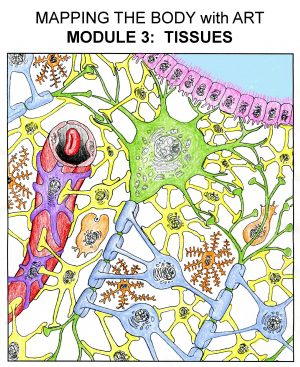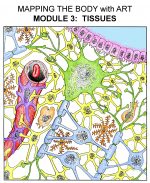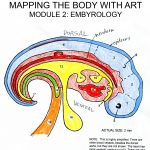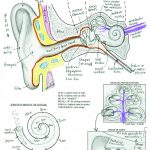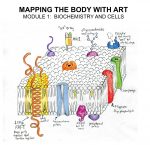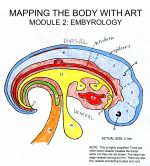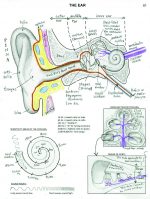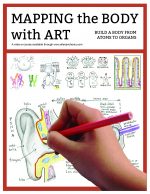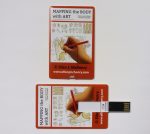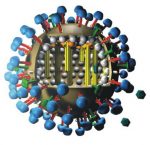Mapping the Body with Art VIDEO E-COURSE — (Part 3- Tissues)
$29.95
This is a VIDEO e-course, not a book.
This is the third module in a full year high school course in anatomy and physiology. The curriculum starts with just a water molecule and builds its way up until students are drawing cells and tissues, and then organs and organ systems. What makes this course different from most others is that it is not based on a textbook and does not require a lot of reading. Text pages are provided, but are not strictly necessary if the student is a good listener and does a good job of drawing along with the video lessons, watching the supplemental videos, and doing the activities. This makes the course ideal for audio and kinetic learners. However, visual learners will also enjoy it, as well, especially if they like to draw. No special artistic skill or previous knowledge is required for the drawing lessons.
BUY ALL 4 MODULES TOGETHER AND SAVE $20! Use this coupon code at checkout: MAPPINGBODY1234
- Description
Description
This third module (lessons 30-54) is a study of the various tissue types (see list below). Each lesson provides a drawing video, a page of text that summarizes the information presented in the drawing, an online quiz, and a few supplemental activities such as a supplemental video, an online lab, an experiment or lab you can do at home, a game to play, a crossword puzzle, or an extra art project.
PLEASE NOTE: Purchasing this video ecourse only gives you access to the videos and all the downloads. You still have to print out the template pages yourself. If you would like to avoid a lot of printing, check out the workbook that is now available in the STORE. Depending on how much it costs for you to print, buying this workbook might actually save you money in the long run. Color copies of game pages are included in the back, as well as quarter-page samples of all the final drawings, in color.
CLICK HERE TO WATCH A 7-MINUTE VIDEO SHOWING HOW TO ACCESS THE COURSE, plus SOME SAMPLE ACTIVITIES
******************************************
FAQs
1)Are there any special tools or materials required? Not really, although I do recommend the brand of colored pencils I use in the videos, which is Berol Prismacolor. But some people like other brands better. Just don’t go cheap on your colored pencils– the art quality ones are worth the price. I buy small sets on Amazon, but for large sets I use a 40% off coupon at my local craft store.
2) Can a middle school student do this course? Maybe. The content is challenging. A motivated/gifted 7th or 8th grader could probably do it. They could certainly do Module 1. It gets harder as we go along just because we are constantly adding new parts and more vocabulary.
3) Can I do this with two or more siblings? Yes. The only issue would be the quizzes, but there is a reset button. You can have each student keep track of their own quiz scores. Or, if you really want each student to have their own account and work independently, there is a way to do this. After purchasing the course, set up extra account(s) for the extra student(s). Then email me letting me know these extra email addresses, and I will enter them into the learner management section on the admin for the course. ejm.basementworkshop@gmail.com
4) Can this be used with a group? Yes, you are welcome to view the videos together as a group. If you want the members of the group to have access to the videos and quizzes at home, I can give a 50% discount to each member of the group. Just email me about this. ejm.basementworkshop@gmail.com
5) Can I do this module if I didn’t do module 1? Only if you have done a pretty thorough unit on cell biology previously. But if you have already studied cell biology, then yes, you could probably hop in here.
*****************************************
Table of Contents:
(Lessons 30, 31, 32, 40 and 49 are available (free) for you to preview – see links below)
Epithelial Tissue
30: Tissue types, and intro to Epithelial tissue
31: Epithelial Tissue (part 2)
Connective Tissue
32: Connective Tissue Overview and Collagen
33: Loose connective tissue (part 1 of Fibrous)
34: Dense and Adipose Fibrous / Cartilaginous Tissue
35: Bone cells and the Osteon
36: Bones make blood cells
37: Blood (as a tissue)
38: The Clotting Cascade
39: Erythrocytes
41: Neutrophils
42: Macrophages
43: B cells
44: T cells (part 1)
45: T cells (part 2)
46: T cells (part 3)
47: How T cells and B cells work together
48: Immune system overview
Nervous Tissue
50: Nervous tissue of the PNS
51: Nervous tissue of the CNS
52: The action potential and the synapse
Muscle Tissue
53: Muscle fibers and the neuromuscular junction
54: Actin and myosin
Final Exam/Review

